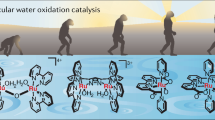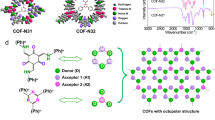Abstract
Water oxidation catalysis constitutes the bottleneck for the development of energy-conversion schemes based on sunlight. To date, state-of-the-art homogeneous water oxidation catalysis is performed efficiently with expensive, toxic and earth-scarce transition metals, but 3d metal-based catalysts are much less established. Here we show that readily available, environmentally benign iron coordination complexes catalyse homogeneous water oxidation to give O2, with high efficiency during a period of hours. Turnover numbers >350 and >1,000 were obtained using cerium ammonium nitrate at pH 1 and sodium periodate at pH 2, respectively. Spectroscopic monitoring of the catalytic reactions, in combination with kinetic studies, show that high valent oxo-iron species are responsible for the O–O forming event. A systematic study of iron complexes that contain a broad family of neutral tetradentate organic ligands identifies first-principle structural features to sustain water oxidation catalysis. Iron-based catalysts described herein open a novel strategy that could eventually enable sustainable artificial photosynthetic schemes.
This is a preview of subscription content, access via your institution
Access options
Subscribe to this journal
Receive 12 print issues and online access
$259.00 per year
only $21.58 per issue
Buy this article
- Purchase on Springer Link
- Instant access to full article PDF
Prices may be subject to local taxes which are calculated during checkout




Similar content being viewed by others
References
US Energy Information Administration. International Energy Outlook DOE/EIA-0484 (Office of Integrated Analysis and Forecasting, US Department of Energy).
Hoffert, M. I. et al. Energy implications of future stabilization of atmospheric CO2 content. Nature 395, 881–884 (1998).
Lewis, N. S. Energy and Transportation 33–39 (The National Academies Press, 2003).
Ciamician, G. The photochemistry of the future. Science 36, 385–394 (1912).
Turner, J. A. Sustainable hydrogen production. Science 305, 972–974 (2004).
Dempsey, J. L. et al. Molecular chemistry of consequence to renewable energy. Inorg. Chem. 44, 6879–6892 (2005).
Yano, J. et al. Where water is oxidized to dioxygen: structure of the photosynthetic Mn4Ca cluster. Science 314, 821–825 (2006).
Chen, X., Shen, S., Guo, L. & Mao, S. S. Semiconductor-based photocatalytic hydrogen generation. Chem. Rev. 110, 6503–6570 (2010).
Magnuson A. et al. Biomimetic and microbial approaches to solar fuel generation. Acc. Chem. Res. 42, 1899–1909 (2009).
Tong, L., Duan, L., Xu, Y., Privalov, T. & Sun, L. Structural modifications of mononuclear ruthenium complexes: a combined experimental and theoretical study on the kinetics of ruthenium-catalyzed water oxidation. Angew. Chem. Int. Ed. 50, 445–449 (2011).
McDaniel, N. D., Coughlin, F. J., Tinker, L. L. & Bernhard, S. Cyclometalated iridium(III) aquo complexes: efficient and tunable catalysts for the homogeneous oxidation of water. J. Am. Chem. Soc. 130, 210–217 (2008).
Hull, J. F. et al. Highly active and robust Cp* iridium complexes for catalytic water oxidation. J. Am. Chem. Soc. 131, 8730–8731 (2009).
Lalrempuia, R., McDaniel, N. D., Müller-Bunz, H., Bernhard, S. & Albrecht, M. Water oxidation catalyzed by strong carbene-type donor–ligand complexes of iridium. Angew. Chem. Int. Ed. 49, 9765–9768 (2010).
Enthaler, S., Junge, K. & Beller, M. Sustainable metal catalysis with iron: from rust to a rising star? Angew. Chem. Int. Ed. 47, 3317–3321 (2008).
Ruettinger, W. F., Campana, C. & Dismukes, G. C. Synthesis and characterization of Mn4O4L6 complexes with cubane-like core structure: a new class of models of the active site of the photosynthetic water oxidase. J. Am. Chem. Soc. 119, 6670–6671 (1997).
Brimblecombe, R., Swiegers, G. F., Dismukes, G. C. & Spiccia, L. Sustained water oxidation photocatalysis by a bioinspired manganese cluster. Angew. Chem. Int. Ed. 47, 7335–7338 (2008).
Dismukes, G. C. et al. Development of bioinspired Mn4O4-cubane water oxidation catalysts: lessons from photosynthesis. Acc. Chem. Res. 42, 1935–1943 (2009).
Limburg, J. et al. A functional model for O–O bond formation by the O2-evolving complex in photosystem II. Science 283, 1524–1527 (1999).
Kanan, M. W. & Nocera, D. G. In situ formation of an oxygen-evolving catalyst in neutral water containing phosphate and Co2+. Science 321, 1072–1075 (2008).
Yin, Q. et al. A fast soluble carbon-free molecular water oxidation catalyst based on abundant metals. Science 328, 342–345 (2010).
Huang, Z. et al. Efficient light-driven carbon-free cobalt-based molecular catalyst for water oxidation. J. Am. Chem. Soc. 133, 2068–2071 (2011).
Ellis, W. C., McDaniel, N. D., Bernhard, S. & Collins, T. J. Fast water oxidation using iron. J. Am. Chem. Soc. 132, 10990–10991 (2010).
Company, A. et al. Alkane hydroxylation by a nonheme iron catalyst that challenges the heme paradigm for oxygenase action. J. Am. Chem. Soc. 129, 15766–15767 (2007).
Company, A. et al. Modeling the cis-oxo-labile binding site motif of non-heme iron oxygenases: water exchange and oxidation reactivity of a non-heme iron(IV)–oxo compound bearing a tripodal tetradentate ligand. Chem. Eur. J. 17, 1622–1634 (2011).
Garcia-Bosch, I. et al. Evidence for a precursor complex in C–H hydrogen atom transfer reactions mediated by a manganese(IV)–oxo complex. Angew. Chem. Int. Ed. 50, 5648–5653 (2011).
Fukuzumi, S. et al. Crystal structure of a metal ion-bound oxoiron(IV) complex and implications for biological electron transfer. Nature Chem. 2, 756–759 (2010).
Morimoto, Y. et al. Metal ion-coupled electron transfer of a nonheme oxoiron(IV) complex: remarkable enhancement of electron-transfer rates by Sc3+. J. Am. Chem. Soc. 133, 403–405 (2011).
Chen, Z. et al. Nonaqueous catalytic water oxidation. J. Am. Chem. Soc. 135, 17670–17673 (2010).
Fukuzumi, S., Kotani, H., Lee, Y-M. & Nam, W. Sequential electron-transfer and proton-transfer pathways in hydride-transfer reactions from dihydronicotinamide adenine dinucleotide analogues to non-heme oxoiron(IV) complexes and p-chloranil. Detection of radical cations of NADH analogues in acid-promoted hydride-transfer reactions. J. Am. Chem. Soc. 130, 15134–15142 (2008).
Comba, P., Fukuzumi, S., Kotani, H. & Wunderlich, S. Electron-transfer properties of an efficient nonheme iron oxidation catalyst with a tetradentate bispidine ligand. Angew. Chem. Int. Ed. 49, 2622–2625 (2010).
Wang, D., Zhang, M., Bühlmann, P. & Que, L. Jr Redox potential and C–H bond cleaving properties of a nonheme Fe(IV)=O complex in aqueous solution. J. Am. Chem. Soc. 132, 7638–7644 (2010).
Jensen, M. P. et al. High-valent nonheme iron. Two distinct iron(IV) species derived from a common iron(II) precursor. J. Am. Chem. Soc. 127, 10512–10525 (2005).
Company, A. et al. Olefin-dependent discrimination between two nonheme HOFe(V)=O tautomeric species in catalytic H2O2 epoxidations. Chem. Eur. J. 15, 3359–3362 (2009).
Bassan, A., Blomberg, M. R. A., Siegbahn, P. E. M. & Que, L. Jr A density functional study of O–O bond cleavage for a biomimetic non-heme iron complex demonstrating an FeV-intermediate. J. Am. Chem. Soc. 124, 11056–11063 (2002).
Quinonero, D., Morokuma, K., Musaev, D. G., Mas-Balleste, R. & Que, L. Jr Metal–peroxo versus metal–oxo oxidants in non-heme iron-catalyzed olefin oxidations: computational and experimental studies on the effect of water. J. Am. Chem. Soc. 127, 6548–6549 (2005).
Dau, H. et al. The mechanism of water oxidation: from electrolysis via homogeneous to biological catalysis. ChemCatChem 2, 724–761 (2010).
Garcia-Bosch, I., Company, A., Fontrodona, X., Ribas, X. & Costas, M. Efficient and selective peracetic acid epoxidation catalyzed by a robust manganese catalyst. Org. Lett. 10, 2095–2098 (2008).
Costas, M. & Que, L. Jr Ligand topology tuning of iron-catalyzed hydrocarbon oxidations. Angew. Chem. Int. Ed. 41, 2179–2181 (2002).
Suzuki, K., Oldenburg, P. D. & Que L. Jr Iron-catalyzed asymmetric olefin cis-dihydroxylation with 97% enantiomeric excess. Angew. Chem. Int. Ed. 47, 1887–1889 (2008).
Britovsek, G. J. P., England, J. & White, A. J. P. Non-heme iron(II) complexes containing tripodal tetradentate nitrogen ligands and their application in alkane oxidation catalysis. Inorg. Chem. 44, 8125–8134 (2005).
Lim, M. H. et al. An FeIV=O complex of a tetradentate tripodal nonheme ligand. Proc. Natl Acad. Sci. USA 100, 3665–3670 (2003).
Nam, W., Ho, R. Y. N. & Valentine, J. S. Iron–cyclam complexes as catalysts for the epoxidation of olefins by 30% aqueous hydrogen peroxide in acetonitrile and methanol. J. Am. Chem. Soc. 113, 7052–7054 (1991).
Roelfes, G. et al. End-on and side-on peroxo derivatives of non-heme iron complexes with pentadentate ligands: models for putative intermediates in biological iron/dioxygen chemistry. Inorg. Chem. 42, 2639–2653 (2003).
Acknowledgements
We thank R. Hage, X. Ribas and P. Lahuerta for reading this work and for comments. We thank the European Research Foundation for project FP7-PEOPLE-2010-ERG-268445 (J.Ll.), El Ministerio de Ciencia e Innovación for project CTQ2009-08464 (M.C.), for a Ramon y Cajal contract (J.Ll.) and for a PhD grant (I.G-B.), Generalitat de Catalunya for an ICREA Academia Award and the European Research Council for Project ERC-2009-StG-239910 (M.C.). RahuCat is acknowledged for giving the tritosylTACN.
Author information
Authors and Affiliations
Contributions
J.Ll. and M.C. devised the initial concept for the work and designed the experiments. Z.C., I.G-B., L.G. and J.Ll. carried out the experiments. J.J.P. and J.Ll. designed the differential pressure transducer hardware and software. Z.C., I.G-B. and J.Ll. analysed the data. J.Ll. and M.C. co-wrote the manuscript.
Corresponding authors
Ethics declarations
Competing interests
The authors declare no competing financial interests.
Supplementary information
Supplementary information
Supplementary information (PDF 2359 kb)
Supplementary information
Supplementary Movie S1 (MP4 13596 kb)
Rights and permissions
About this article
Cite this article
Fillol, J., Codolà, Z., Garcia-Bosch, I. et al. Efficient water oxidation catalysts based on readily available iron coordination complexes. Nature Chem 3, 807–813 (2011). https://doi.org/10.1038/nchem.1140
Received:
Accepted:
Published:
Issue Date:
DOI: https://doi.org/10.1038/nchem.1140
This article is cited by
-
Lamella-heterostructured nanoporous bimetallic iron-cobalt alloy/oxyhydroxide and cerium oxynitride electrodes as stable catalysts for oxygen evolution
Nature Communications (2023)
-
Cobalt-based Metalloporphyrins As Efficient Electro-catalysts for Hydrogen Evolution From Acetic Acid and Water
Electrocatalysis (2023)
-
On the origin of multihole oxygen evolution in haematite photoanodes
Nature Catalysis (2022)
-
Transition Metal Based Coordination Complexes as Catalysts for Water Oxidation
Resonance (2022)
-
Competitive interaction of Mn(II) and Fe(II) cations with the high-affinity Mn-binding site of the photosystem II: evolutionary aspect
Origins of Life and Evolution of Biospheres (2022)



